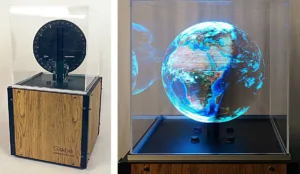Catleytech (London, UK) is developing a spherical volumetric display. It is formed from a ring of rotating LEDs and depends on the persistence of vision effect.
The imaging system in the Globe includes a circular disk with 256 RGB LEDs mounted around its edge. The disk is spun about its vertical axis at a rate of 15 rotations per second. The output of the LEDs are updated 1920 times during every rotation. The persistence of vision effect blends these updates into a continuous image.
The persistence of vision effect is a characteristic of the human vision system. It is defined as “the retention of a visual image for a short period of time after the removal of the stimulus that produced it.” The period of retention is in the range of from 1/10th to 1/15th of a second. By the means described above, it is possible to create a spherical display of 491,520 pixels that can be viewed from all angles.
Based on Raspberry Pi (see Wikipedia to learn more), Globe is capable of displaying images, video and other types of content that the user might put on a conventional monitor.
The company web site explains that an HDMI source generates the image data, an FPGA then buffers each image and distributes it to the appropriate LED driver.
The photos below illustrate the appearance of the Globe. A video at the end of this article presents the Globe in operation and discusses the technology.
The Globe: off condition on the left and on condition on the right.
Additional specifications for the Globe display include the following:
- Display diameter: 310 mm
- Overall housing dimensions: 400 mm x 400 mm x 700 mm
- Weight: 15 kg
- Housing material: anodized aluminum, wood veneer (multiple options)
- Display case: Perspex
- Power: 100 – 240V AC 50/60 Hz (cable provided)
Globe will come with an Android and an IOS app along with a “straightforward web interface.” The user can then upload their own media or select from a range of prebuilt content. Prebuilt content provided along with the Globe will allow the user to display solar bodies such as Mars, Jupiter or even Ganymede, with their real time day and night cycles. “It will also be possible to overlay a range of meteorological and environmental data onto the earth, such as cloud cover, wind speed, air pressure, temperature, lightning strikes and earthquakes, as well as human influences like air and marine traffic, national borders, rocket launches and satellite positions.”
The Globe display justifiably claims to be eye catching. Couple this with the fact that it can be seen from all angles and the company’s representation that the Globe is well suited for advertising and artistic displays is easy to believe. “By placing it in the center of a room, it is sure to draw everyone’s gaze.”
At the time this article is written, the company reports that a proof of concept prototype has been built. “This includes the vast bulk of the firmware coding, the majority of the PCB design and general mechanical design. The next revision of the PCB design has been completed and is ready to be submitted for manufacture.”
The company is using a Kickstarter campaign to raise the funds needed to bring the Globe into full production. The campaign can be found here. At the time this article is written, $14,694 has been pledged by 25 backers towards a goal of $26,548. The campaign is scheduled to conclude on November 10th. It might be noted that last month the company concluded an unsuccessful Kickstarter campaign for the same product. Acknowledging that there were errors (as well as “bad luck”) in the earlier campaign, adjustments and corrections have been made in this second campaign. Assuming that the new Kickstarter campaign is successful, the company plans the following schedule to roll out the product.
- October – November:Kickstarter campaign
- November – March:Contract software development. Hardware development.
- March – April:Build pre-production prototype and finalize designs
- April:Order all components
- May: Assemble all Globes
- June:Quality control and safety testing
- July: Ship
It seems that the anticipated initial selling price of the Globe will be about $755. -Arthur Berman
Analyst Comment
Dynascan of the US has long been developing this kind of rotating LED display, but in a cylindrical form. Lightvert of the UK has also used the presistence effect to create virtual outdoor displays. (Lightvert Now On the BBC). (BR)

